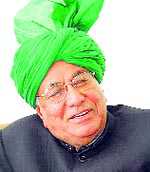
Om Prakash Chautala
Sushil Manav in Chandigarh
The ‘khula darbar’ culture is not new for chief ministers, ministers and bureaucrats at district level in Haryana. The trend goes back to three decades when Chaudhary Devi Lal, who became chief minister in 1987, started it. Later, his son Om Prakash Chautala who remained chief minister for three brief terms since 1989 to 2005 used the darbar culture to the hilt.
From July 24, 1999, to March 4, 2005, Chautala organized more than 400 khula darbars and visited each of the 90 assembly segments of the state at least four times in these nearly six years.
“During these darbars, Chautala made nearly 80,000 announcements about development activities, including those at the village level such as construction of streets, drains or boundary walls of cremation grounds,” said an officer who was associated with these darbars.
A retired officer of the development and panchayat department says most of the announcements were routine small village level development works which should best have been decided by panchayats themselves.
“In a way, all the powers of the panchayats were usurped and the decisions which should have been taken at the village chaupal were announced by the CM office,” he said.
Former CMs Bansi Lal and Bhupinder Singh Hooda never believed in these darbars”, while Bhajan Lal held informal meetings, especially in his own Adampur assembly segment.
Chief Minister Manohar Lal Khattar started it off from his home constituency within a month of taking over in 2014 and covered all the districts of the state before launching the CM Window, a digital platform through which people can approach him by handing their complaints at windows set up in the districts.
“Khula darbars hardly serve any purpose. For days before the darbars, the deputy commissioners keep us busy in preparations much to the annoyance of regular visitors to the secretariat. During darbars, too, only a few grievances are actually resolved as most of the complainants are sponsored ones. Their appearance before the CM is merely stage-managed for the feel-good factor,” says a district-level officer who refused to be identified.
The officer cites the case of Mewat where Khattar recently suspended civil surgeon Shriram Siwach while the grievance of the complainant was against another doctor posted in the district. Even as Siwach was explaining his position, some BJP leaders who had been nursing a grouse against the officer misguided Khattar who announced the medical officer’s suspension from the dais. With barely one month left for his retirement, Siwach will now have to face the ignominy as well as the hardships for no fault.
Similarly, in November 2015, then Fatehabad SP Sangeeta Kalia had a tiff with health minister Anil Vij after the latter asked her to get out of the meeting hall. Later, it was known that some local BJP leaders unhappy with the officer had misguided the minister.
“The utility of khula darbars depends on the attitude of the political leader holding it. Before acting against an officer, an opportunity must be given to her/him to offer his point of view. Though suspension is not considered a punishment under the service rules, it has its implication on the officer as well as his family members,” says Yudhbir Singh Khyalia, a retired IAS officer.
He says during his tenure as SDM and DC, he ensured that mutations of land records which were left pending by revenue officials for vested interests were entered on the spot during open darbars. “If the intentions of the leader are good, the khula darbars can prove to be a boon for the common people,” says Khyalia.
Fateh Singh Dagar, another retired IAS officer from Haryana, says he was the one who persuaded Chaudhary Devi Lal to introduce such darbars. He says khula darbars ensure accessibility of the officers to the common people. “This in turns reduces corruption in the system.”



























